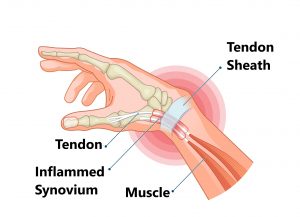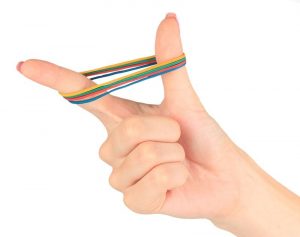De Quervains – Post Pregnancy Wrist Pain. How to treat it?

Do you have wrist pain or pain around the base of the thumb (as shown above)? Often when lifting objects? Have you recently had a baby?
You might have De Quervains tenosynovitis.
In this article I will outline what De Quervains is, how you can manage is and how to progress back to your best with 3 easy exercises.
De Quervains tenosynovitis is a type of wrist pain that is found mostly in women with newborn babies due to the increased load on tendons around the wrist from lifting the baby up off the ground. However, it can also occur in anyone who’s suddenly had a dramatic increase in wrist and hand related activities such as gripping, grasping, pinching or squeezing. De Quervains tenosynovitis is the inflammation of the fluid filled sheath that surrounds the tendons on the radial (thumb side) side of the wrist. The tendons affected are called the Abductor Pollicis Longus (APL) and the Extensor Pollicis Brevis (EPB) muscles.
Management
Due to this condition being predominantly an overuse type of injury, the first step to reducing pain is to offload the tendons. Firstly, you need to identify those activities that are aggravating, whether this is lifting the newborn baby, gardening or computer work. Avoid these activities when possible. When lifting a baby, use the injured hand facing up to “scoop” the baby up with that hand. Taking anti-inflammatories and icing the area can help reduce pain. These are the first few steps that are most often required to bring symptoms down to a tolerable level.

From here it is necessary to begin to improve pain-free range of motion and strengthen the tendons. Below I will outline 3 exercises that will help you get back to ultimate wrist and hand function. It’s important to note that if these exercises flare up your symptoms for hours after and into the next day, then you will need more time to offload.
Exercise 1 – Range of motion: These exercises will help the gliding of the painful tendons within the tendon sheath and improve your pain free range. Perform the following thumb movements up to 30 times each. If you cannot tolerate the full movement then reduce the amount of movent in the intended direction until pain is tolerable.
Exercises 2 & 3 – Strengthening: This exercise is to help directly strengthen the injured thumb tendons.
- Isometric hold: An isometric hold is when a contraction of the muscles occur without movement. Wrap a rubber band around your thumb and index finger. Gently pull the rubber band away and hold for 10 seconds. Only pull as far as you are comfortable pain-wise. Perform 10 x 10 second holds.
- Concentric/Eccentric: This is your more typical type of strengthening and should only be commenced once isometrics are able to be performed with full range of motion and without pain. Pull the rubber band, then let go slowly, and repeat. Complete 3 sets of 10 repetitions.

I hope this article has been helpful. If you have any questions, please call us at 9569 5145 or make a booking online here.
References for pictures.
https://www.google.com/search?q=de+quervain%27s+tenosynovitis&sxsrf=ALeKk017nIx9m4I7h7_TtoelUsGHw5sXyg:1619070266973&source=lnms&tbm=isch&sa=X&ved=2ahUKEwj4hYThkpHwAhW_xzgGHWUdApYQ_AUoAXoECAEQAw&biw=1920&bih=969#imgrc=BfWOMJH_f9lk4M
https://www.google.com/search?q=de+quervain%27s+tenosynovitis+baby&tbm=isch&ved=2ahUKEwjRve3hkpHwAhVGcSsKHbUoAcwQ2-cCegQIABAA&oq=de+quervain%27s+tenosynovitis+baby&gs_lcp=CgNpbWcQAzIECAAQGDoCCAA6BggAEAgQHlCY6gNYyvADYOLyA2gAcAB4AIABnwGIAfMFkgEDMC41mAEAoAEBqgELZ3dzLXdpei1pbWfAAQE&sclient=img&ei=PA2BYNGvKsbirQG10YTgDA&bih=969&biw=1920#imgrc=kJIjkMKjvUrN6M
https://www.google.com/search?q=rubber+band+thumb+exercises&tbm=isch&ved=2ahUKEwixlOCAk5HwAhXqoEsFHURDB9AQ2-cCegQIABAA&oq=rubber+band+thumb+&gs_lcp=CgNpbWcQARgAMgIIADIECAAQGDoECCMQJzoECAAQQzoFCAAQsQM6BwgAELEDEENQotADWKrlA2Cj7gNoAHAAeACAAeABiAGzFpIBBjAuMTcuMZgBAKABAaoBC2d3cy13aXotaW1nwAEB&sclient=img&ei=fQ2BYPHhHerBrtoPxIadgA0&bih=969&biw=1920#imgrc=DQOGADIVEp6qiM
